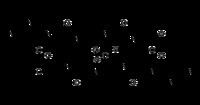Formula C51H64N12O12S2 | Molar mass 1,101.26 g/mol | |
 | ||
Medical vocabulary what does echinomycin mean
Echinomycin is a peptide antibiotic. It intercalates into DNA at two specific sites, thereby blocking the binding of hypoxia inducible factor 1 alpha (HIF1alpha).
Contents
How to pronounce echinomycin
Biosynthesis
Echinomycin is a bis-intercalator peptide and is biosynthesized by a unique nonribosomal peptide synthetase (NRPS). Echinomycin is isolated from various bacteria such as Streptomyces lasalienis. It belongs to a family of quinoxaline antibiotics. There is great interest in this group of compounds because they have very potent antibacterial, anticancer, and antiviral activities.
The biosynthesis of echinomycin starts with molecule QC. L-tryptophan is the precursor for QC and its biosynthesis parallels the first stage of nikkomycin biosynthesis. After QC is biosynthesized, the adenylation domain-containing Ecm1 activates and transfers QC to FabC using the fatty acid biosynthesis acyl carrier protein (ACP). The first module, Ecm6 accepts the QC-SFabC as the starter unit. Emc7 contains a terminal thioesterase domain which allows the peptide to dimerize and then release. This cyclized product then goes on to Ecm17, an oxioreductase, creating a disulfide bond. The last step in this biosynthesis transforms the disulfide bond into a thioacetal bridge. This transformation takes place with Ecm18, which is quite similar to S-adenosyl-L-methionine (SAM)-dependent methyltransferase.
